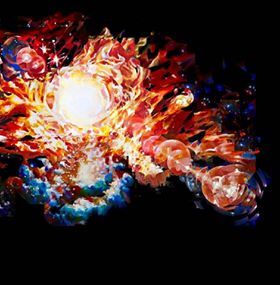Identity
David Ditchfield's Remarkable Near-Death Experience
Transformation on the verge of death
Posted July 6, 2020 Reviewed by Lybi Ma

In 2006, a man called David Ditchfield was seeing off a friend at a train station near Cambridge, England. He stepped on to the train to help his friend with her luggage and to hug her goodbye, but as he stepped back off, his long coat got stuck in the train’s closing doors. Unable to take off the coat, he found himself trapped as the train set off. He was pulled along the platform as the train gathered speed, being ‘tossed around like a rag doll.’ Then he was sucked into the gap between the train and the platform and ended up on the train track, with the train hurtling by above him.
Despite the danger, David felt strangely calm. To maximise his chances of survival he pushed himself as far down into the track as he could. The final carriage of the train passed over him and he felt a surge of joy that he had survived, although now he felt intense pain. He noticed that the left sleeve of his coat had been ripped to shreds and then that his arm had been severed from the elbow down. As he says, ‘Everything unfolded in a slow dream-like way…I felt an unearthly, absolute sense of calmness.’
David was rushed to hospital by paramedics, with his life hanging in the balance, as he was losing so much blood. Shortly after arriving at the hospital, he lost normal consciousness and suddenly found himself in a completely different environment, immersed in a darkness that seemed warm and soft, with vivid colors and lights around him. There was no pain anymore, and he felt very tranquil. This is how he described his experience, in an interview with me:
I could see pulsating colors like little orbs, much brighter and sharper than any colours I’d seen in my normal life. Watching them was really relaxing and therapeutic. It was such a beautiful place, with a feeling that I was being cared for and supported. I thought that this is what it must be like to die – and then wondered if it meant that I had just died…
The sensation of love became stronger and as I looked at my feet, I saw a huge tunnel of light drawing closer towards me. I felt, and I still believe this now, that the white light was the source of all creation. I never dreamt I would ever see something so beautiful… It was the light of pure, unconditional love. Every molecule of my body was pulsating with love and light. It was the most incredible sensation. I felt more alive than I have ever done before. It felt like I was experiencing the true reality, while my old world was just an illusion. At that point, I felt certain that I was dead but I didn’t feel any fear or regret… I lay my head back and laughed because I felt so joyous. Then suddenly I was back in hospital, with an overdrive of noise and light and people and frantic voices. I was being rushed into theatre.
Attempted Explanation of Near-Death Experiences
David’s experience is a remarkable example of what is usually referred to as a ‘near-death experience.’ NDEs occur when a person’s brain and body shut down for a short period of time before they are resuscitated – for example, after cardiac arrest. In many cases, people report that – even though their brain showed no signs of activity – they continued to be conscious and underwent a remarkable series of experiences, usually along similar lines to David’s. Such experiences are surprisingly common. For example, research suggests that around a third of cardiac arrest patients report them after resuscitation.
As I point out in my book Spiritual Science, NDEs are controversial because there is no viable neurological or physiological explanation for them. Many suggestions have been made, for example, that they are caused by cerebral anoxia (lack of oxygen to the brain), undetected brain activity, or the release of "psychedelic chemicals" like ketamine. From this point of view, NDEs are nothing more than brain created hallucinations, no more real than dreams.
But there are problems with all of these explanations. Cerebral anoxia usually results in chaotic hallucinatory experiences and is associated with confusion and memory loss. But people report NDEs as unlike this. They are usually very serene, structured, and well-integrated experiences. Research has shown no significant similarity between psychedelic experiences and NDEs, and there is no evidence that the brain has a hidden store of psychedelic chemicals that are released when we are close to death.
It is also difficult to see how NDEs could be due to undetected brain activity, when, after cardiac arrest, brain stem reflexes are lost straight away, and do not return until the heart has been restarted. How could a brain be functioning without showing any signs of activity? In any case, if there was some undetected brain activity, it would have to be incredibly low, and it seems unlikely that such a low level of brain activity could produce very intense, apparently conscious experiences.
The Long Term Effects of NDEs
One of the most striking things about near-death experiences is their long-term effect. Although they may only last for a few seconds of normal time, near-death experiences usually have a powerful transformational effect. David Ditchfield's experience is an excellent example of this. His NDE changed him so dramatically that he feels as if he has a different life and a different identity, almost as if he is a different person living in the same body. Even after 14 years, these changes have not diminished. As David told me:
I feel like I’m living in different dimensions rather than just one. I’m much more sensitive and can pick up on the energy of places and people. It has made my life so much more interesting… I have a lot more appreciation for nature, and the world seems a beautiful place. I love watching animals and insects, watching the seasons change. Before the experience, I was so immersed in myself that all of those things just didn’t exist for me. They were just there.
It’s changed my relationships too. I’m a lot more understanding, rather than feeling disappointed with people. I have a much broader take on how people work. That helps me to be more supportive of the people around me.
David began to paint as a way of depicting the visions he had seen (one of his paintings is at the beginning of this article). He also learned to compose classical music as another way of conveying the incredible sense of peace and calmness he had experienced. (Some of his music is here.)
These long-term changes are typical for NDEs. They almost always bring about a profound shift of values and perspective, which itself leads to major lifestyle changes. People often become less materialistic and more altruistic, less self-oriented, and more compassionate. Like David, they often report becoming more sensitive to beauty and more appreciative of everyday things.
The fact that they have such profound after-effects makes it seem very unlikely that NDEs are a brain-generated hallucination. Hallucinations are usually quickly forgotten, with a clear sense that they were delusional experiences, less authentic and reliable than ordinary consciousness. Even though they seem to contradict our standard, materialistic view of reality, we have no option but to be open to the idea that NDEs are authentic experiences.
In fact, as I point out in Spiritual Science, NDEs are one of many phenomena that suggest that our normal view of reality is limited. They remind us that, to paraphrase Shakespeare, there are more things in heaven and earth than are dreamt of in our standard scientific worldview. NDEs point towards a different vision of the world in which consciousness isn’t directly produced by the brain, but is in some sense fundamental and universal.
References
David Ditchfield has recently published Shine On, a book about his near-death experience. More information here.




